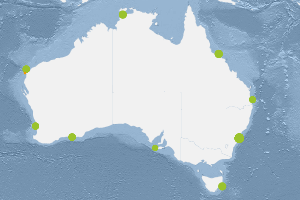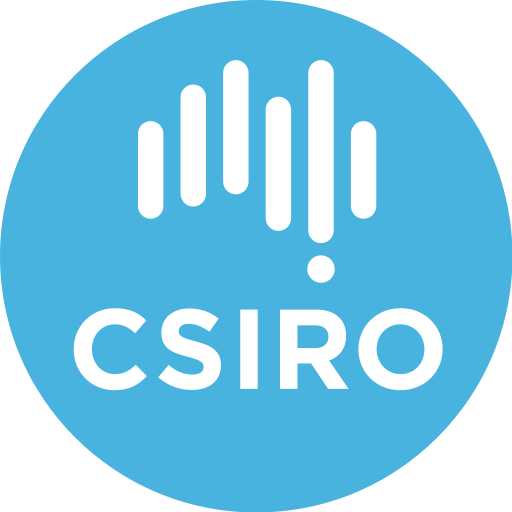cl_maintenanceAndUpdateFrequency
asNeeded
1599 record(s)
Type of resources
Topics
Keywords
Contact for the resource
Provided by
Years
Formats
Representation types
Update frequencies
Status
draft
-
This dataset contains data collected by the Australian Continuous Plankton Recorder (AusCPR) survey and is funded by IMOS (Ships of Opportunity sub-facility) and CSIRO. The aims of the AusCPR survey are to: * map plankton biodiversity and distribution * develop the first long-term plankton baseline for Australian waters * document plankton changes in response to climate change * provide indices for fisheries management * detect harmful algal blooms * validate satellite remote sensing * initialise and test ecosystem models. The survey conducts repeat tows in the GBR, the East Australian Current and down to the Southern Ocean Time Series Mooring (SOTS). Other routes are conducted on an adhoc nature around Australia. The dataset also contains phytoplankton data from the UTAS / AAD led Southern Ocean CPR (SOCPR) project which is also funded by IMOS. The datasets available in this collection include Phytoplankton Colour Index (an estimate of chlorophyll in the water), phytoplankton abundance, zooplankton abundance and a biomass index from AusCPR and phytoplankton abundance from SOCPR. This data are freely available through the AODN portal: https://portal.aodn.org.au. This data is freely available but please acknowledge all relevant parties, as detailed in acknowledgement section.
-

This dataset comprises the phytoplankton abundance and biovolume estimates as part of a broader sampling program carried out at the Southern Ocean Time Series, a facility within the Integrated Marine Observing System (IMOS). The primary focus is sustained observing of ocean properties and processes important to climate, carbon cycling, and ocean productivity. Regular phytoplankton samples are collected at approximately 14 day intervals (exact intervals and seasonal coverage dependent on deployment length). The moorings are serviced annually, at which time the existing moorings are recovered and new moorings are deployed. Water samples from within the surface mixed-layer are collected at pre-programmed intervals using a Remote Access Sampler, in pairs about 1 hour apart. One sample in each pair is preserved for phytoplankton community composition by microscopy, and the other sample is preserved and used for accompanying chemical analysis of nutrients, total dissolved inorganic carbon (DIC) and alkalinity. Each sample is collected from within the surface mixed-layer at 32 m depth (2010 - 2017) or 5 m depth (2018-current) depending on the design of the mooring surface assembly and instrumentation. Typically a maximum of 24 samples are collected over an annual deployment cycle. The samples collected are analysed for: 1. Community composition / abundance (cells/L) 2. calculated biovolume (um3/L). Protocols for the phytoplankton time-series are described in Eriksen et al (2018), and the annual sample reports for each deployment. Data storage and access is planned to be interoperable with other national and international programs through the IMOS Infrastructure. Station metadata can be found through this resource. Data is available freely via the AODN portal: https://portal.aodn.org.au. As the taxonomic resolution of the data has changed over time, due to continual training, it is important that users refer to the change log tables included in your data download. These will provide information on the validity of the taxa, from what date we have been identifying certain taxa etc. Classification fields may be blank depending on the level to which that taxa has been identified, i.e. if only identified to family, genus and species will be blank.
-
This record contains data collected from the near-water surface sampling site off the Lucinda Jetty, as part of the Lucinda Jetty Coastal Observatory. Sample collection began the 9th of January, 2014. The data can be used for Ocean Colour sensor validation. Parameters measured include the absorption coefficients of the particulate and dissolved components of the water column and the phytoplankton pigment concentration and composition.
-

Sounding data extracted from: Continental Shelf Research 21 (2001) 157–201 Geochemistry and particle size of surface sediments of Exmouth Gulf, Northwest Shelf, Australia G.J. Brunskill,*, A.R. Orpin, I. Zagorskis, K.J. Woolfe, J. Ellison DOI: 10.1016/S0278-4343(00)00076-5 Project Details: The Pilbara Marine Conservation Partnership (PMCP) was an initiative designed to enhance the net conservation benefits of the globally-significant coral reef ecosystems of the Pilbara (Western Australia) by providing an assessment of the condition and trajectory of key ecological values. These assessments were designed to inform and complement existing governance and management arrangements and the PMCP is intended to provide ongoing advice and assessment for conservation efforts in the region, providing lasting benefits. The PMCP concept is based on three core ecological components, namely: Coral Reef Health - concentrating mainly on habitat forming primary producers. Fish and Sharks - their community structure, interactions and impacts on lower trophic levels. Environmental Pressures - physical and anthropogenic factors that influence the condition of reefs and associated biota.
-

This record describes multibeam echosounder data collected on RV Investigator voyage IN2018_C01, 'RAN Hydrographic Survey' which departed Hobart on the 28th May 2018 and returned to Hobart on the 8th June 2018. The overall focus for this survey was to conduct a modern survey in the primary shipping route through Bass Strait and to To facilitate safe navigation for international and coastal shipping. The Kongsberg EM710 MKII multibeam echosounder was used to acquire seafloor bathymetry and backscatter information (and watercolumn backscatter) near Wilson's Promontory in Bass Strait and during the transit from and to Hobart. The EM710 MKII provides a 0.5° by 1° transmit and receive angular resolution respectively. The echosounder's nominal frequency range is from 40 to 100 kHz. Data are stored in *.all raw format for bathymetry and backscatter and *.wcd format for watercolumn backscatter at CSIRO. There are 372 files totalling 119 GB of raw bathymetry & backscatter data, and 241 files totalling 269 GB of raw watercolumn data in this dataset. Sound velocity profiles were applied to this data during data acquisition. Bathymetry data contained in *.all format are corrected for motion and position. Tide corrections were applied to the processed data. Processed data has had outliers removed. Processed line data are available in *.gsf and ascii format, and processed bathymetry and backscatter grids in geotiff format. Additional information regarding this dataset, including further information on processing streams, is contained in the GSM data acquisition and processing report. Additional data products may be available on request.
-

As part of the Pilbara Marine Conservation Partnership (PMCP), coral reef surveys of reef macroalgae species (including seagrasses) were undertaken between northern Ningaloo and the Dampier Archipelago. This dataset contains biomass estimates (g DW m-2 and g WW m-2) of macrophytes collected in shallow reef areas in the Pilbara region during two sampling trips: November 2013 and May 2014. Surveys were undertaken using using SCUBA at depths between 2-13m, with macroalgae and seagrasses identified to the lowest possible taxonomic level. The data include: * Macroalgae and seagrass diversity (0.25 square metre quadrats) * Macroalgae and seagrass species composition and biomass per quadrat (0.25 square metre) These data were collected to estimate macrophyte biomass in shallow reef areas across the Pilbara region in two contrasting seasons. These data are an output of the Pilbara Marine Conservation Partnership (PMCP) Coral Reef Health Theme.
-

Landsat 8 Images were obtained for the project study area (Pilbara Marine Region). Images acquired were Landsat 8 images (Path: 113,114,115 Rows: 74,75,76) for 2013 ranging from Day 110 - 348 (2013-04-20 to 2013-12-14). Data are comprised of 58 files ranging in size from 500 to 1000 MB in compressed format (46 GB total), and are lodged with the iVEC Data Store - https://data.ivec.org The Pilbara Marine Conservation Partnership (PMCP) was an initiative designed to enhance the net conservation benefits of the globally-significant coral reef ecosystems of the Pilbara (Western Australia) by providing an assessment of the condition and trajectory of key ecological values. These assessments were designed to inform and complement existing governance and management arrangements and the PMCP is intended to provide ongoing advice and assessment for conservation efforts in the region, providing lasting benefits. The PMCP concept is based on three core ecological components, namely: Coral Reef Health - concentrating mainly on habitat forming primary producers. Fish and Sharks - their community structure, interactions and impacts on lower trophic levels. Environmental Pressures - physical and anthropogenic factors that influence the condition of reefs and associated biota.
-
FAO Major Fishing Areas for Statistical Purposes are arbitrary areas, the boundaries of which were determined in consultation with international fishery agencies on various considerations, including (i) the boundary of natural regions and the natural divisions of oceans and seas; (ii) the boundaries of adjacent statistical fisheries bodies already established in inter-governmental conventions and treaties; (iii) existing national practices; (iv) national boundaries; (v) the longitude and latitude grid system; (vi) the distribution of the aquatic fauna; and (vii) the distribution of the resources and the environmental conditions within an area. For various historical reasons the Areas in the Pacific were not so developed, with the exception of Area 87 corresponding to the CPPS area of competence. Initiatives for closer cooperation between agencies in the interest of better data, not only in the field of tunas, have suggested that some changes are necessary to the present FAO fishing areas/boundaries in the Pacific. The boundaries of fishing areas could be modified and adjusted according to new requirements, but it is inadvisable to introduce too frequent amendments to the already established areas. Revisions to boundaries should only be introduced after consultation with all the national fishery authorities and fishery agencies concerned with the areas under revision. Unless there are other over-riding reasons, boundaries lines should be drawn along 5° lines of longitude and latitude.
-

Fish and shark assemblage data are being obtained from the analysis of Stereo-BRUV footage captured in May 2014. Data is comprised of raw camera output stream files (.MTS) for 272 Stereo-BRUV drops in shallow water (~10m) between Exmouth and Dampier, Western Australia. Files are less than 1.9GB and total approximately 10TB. Videos are structured within Stereo-BRUV drops (identified with an OpCode i.e. NCB1-NCB272) with a left and right camera folder within each drop. Videos are lodged with the iVEC Data Store - https://data.ivec.org The Pilbara Marine Conservation Partnership (PMCP) was an initiative designed to enhance the net conservation benefits of the globally-significant coral reef ecosystems of the Pilbara (Western Australia) by providing an assessment of the condition and trajectory of key ecological values. These assessments were designed to inform and complement existing governance and management arrangements and the PMCP is intended to provide ongoing advice and assessment for conservation efforts in the region, providing lasting benefits. The PMCP concept is based on three core ecological components, namely: Coral Reef Health - concentrating mainly on habitat forming primary producers. Fish and Sharks - their community structure, interactions and impacts on lower trophic levels. Environmental Pressures - physical and anthropogenic factors that influence the condition of reefs and associated biota.
-

This project is aimed at understanding how coral growth has responded to past changes in regional climate across northern Ningaloo and the Pilbara region by analysing the physical and geochemical composition of cores collected from massive coral (Porites spp.). X-ray images of the sliced coral cores provide us with information on seasonal and inter-annual changes in the density and rate of vertical extension from which we can calculate annual rates of coral growth, or more precisely, 'calcification'. Coral cores from massive Porites spp. were collected from sites across northern Ningaloo (Tantabiddi and Coral Bay in July 2013) and the western Pilbara (Onslow to the Dampier peninsula in April 2014).
